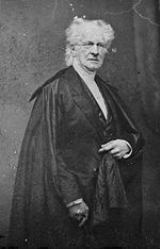
Rembrandt Peale
Encyclopedia
Rembrandt Peale was an American artist and museum keeper. A prolific portrait painter, he was especially acclaimed for his likenesses of presidents George Washington
and Thomas Jefferson
. Peale's style was influenced by French Neoclassicism
after a stay in Paris in his early thirties.
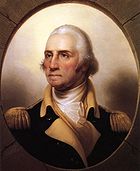 Rembrandt Peale was born the third of six surviving children (eleven had died) to his mother, Rachel Brewer, and father, Charles Willson Peale
Rembrandt Peale was born the third of six surviving children (eleven had died) to his mother, Rachel Brewer, and father, Charles Willson Peale
in Bucks County, Pennsylvania
, on February 22, 1778. The father, Charles, also a notable artist, taught all of his children to paint scenery and portraiture
, and tutored Rembrandt in the arts and sciences. Rembrandt began drawing at the age of eight. A year after his mother’s death and the remarriage of his father, Peale left the school of the arts, and completed his first self-portrait
at the age of 13. The canvas displays the young artist's early mastery. The clothes, however, give the notion that Peale exaggerated what a 13 year old would look like, and Peale's hair curls like the hair of a Renaissance angel. Later in his life, Peale "often showed this painting to young beginners, to encourage them to go from 'bad' to better..."
In July of 1787, Charles Willson Peale introduced his son Rembrandt to George Washington, and the young aspirant artist watched his father paint the future president. In 1795, at the age of 17, Rembrandt painted an aging Washington, making him appear far more aged than in reality. The portrait was well received, and Rembrandt had made his debut.
At the age of 20, Rembrandt married 22-year-old Eleanor May Short (1776–1836) at St. Joseph's Catholic Church in Philadelphia. During their marriage, Rembrandt and Eleanor had nine children: Rosalba, Eleanor, Sarah Miriam, Michael Angelo, and Emma Clara among them.
In 1822, Peale moved to New York City where he embarked on an attempt to paint what he hoped would become the "standard likeness" of Washington. He studied portraits by other artists including John Trumbull
, Gilbert Stuart
and his own father, as well as his own 1795 picture which had never truly satisfied him. His resulting work Patriae Pater, completed in 1824, depicts Washington through an oval window, and is considered by many to be second only to Gilbert Stuart's iconic Athenaeum painting of the first president. Peale subsequently attempted to capitalize on the success of what quickly became known as his "Porthole" picture. Patriae Pater (Latin for "Father of Our Country") was purchased by Congress in 1832 for $2,000. It currently hangs in the Old Senate Chamber.
Peale went on to create over 70 detailed replicas, including one of Washington in full military uniform that currently hangs in the Oval Office
. Peale continued to paint other noted portraits, such as those of the third president Thomas Jefferson while he was in office (1805), and later on a portrait of Chief Justice John Marshall
.
and several other noted patrons such as Joseph Louis Gay-Lussac
and François André Michaux
.
After his successes in France, Peale returned to Philadelphia in 1810. His efforts to establish his knowledge and mastery of art were displayed in his painting The Roman Daughter (1812). The painting was deemed too “sensational” by the people of Philadelphia, who were unsympathetic to his endeavors toward “improving the state of fine arts in America” in the 19th century. Amid the economic hardship of the War of 1812
, President Jefferson—who promised to buy the 1795 portrait of Washington, but could not keep his promise—instead encouraged Peale to go to Europe, as "we have genius among us but no unemployed wealth to reward it".
The museum was elaborately illuminated by gas light
, following the example of his brother Rubens
in Philadelphia. This innovation made a great impression. Peale had acquired an important gas lighting patent, and with some associates founded the successful Gas Light Company of Baltimore. Having poor business sense, though, he did little to manage the company and was forced out after a few years due to the War of 1812.
In 1828 an ambitious Peale raised funds and tried earning money for his previous paintings, in order to travel to Rome. He took along his 15-year-old son, Michael Angelo, a determined young artist who copied his father's paintings in admiration. Peale successfully displayed portraits of Horatio Greenough
and Patriæ Pater in Florence Academy.
Peale died June 12, 1860 in Philadelphia.
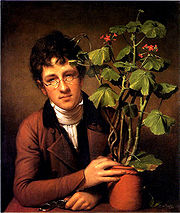 In 1801, Rembrandt painted a portrait of his brother Rubens
In 1801, Rembrandt painted a portrait of his brother Rubens
, youngest of the six Peale children, who always had an admiration for gardening and tending to natural life. Rembrandt seated his brother next to a geranium
. The painting signifies the artist’s admiration for a sibling’s love of nature, and may have been inspired by the Dutch
17th century artist, David Teniers
the Younger, who had painted a series of oil-on-copper paintings representing the five senses. His painting, "Smell" is quite similar to Rembrandt Peale’s. Rembrandt's piece captures the essence of a young gardener/artist’s peace of mind, gracefully looking out, a posture of wonder and calmness.
In 1824 Peale painted the Patriæ Pater, in which a rectangle supporting an oval wreath surrounds the eye-catching image of George Washington. The most successful painting of Peale's 50-year career, it inspired John Marshall
to have his portrait done by Peale in the same fashion. The painting was criticized as lacking authenticity, as it was not completed until after Washington's death (1799). Nonetheless, Peale received commendations for his portrait by many noted politicians such as Washington’s nephew, Judge Bushrod Washington
, who was an associate U.S. Supreme Court Justice, and Marshall.
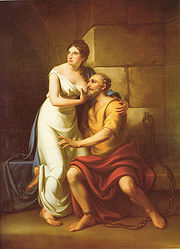 Peale's neoclassical painting The Roman Daughter depicts a young girl shielding her father, a prisoner in chains. This piece demonstrates compassion and graceful defense; his copy of Correggio's Angel, and his immense allegorical painting, Court of Death (1820), reveal the same artistic style.
Peale's neoclassical painting The Roman Daughter depicts a young girl shielding her father, a prisoner in chains. This piece demonstrates compassion and graceful defense; his copy of Correggio's Angel, and his immense allegorical painting, Court of Death (1820), reveal the same artistic style.
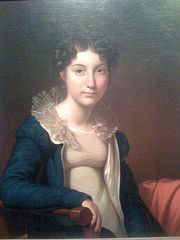 The following is a partial list of collections holding works by Rembrandt Peale:
The following is a partial list of collections holding works by Rembrandt Peale:
—an artist whose style resembled Peale's, and who claimed the picture as his own—was examined by the National Portrait Gallery of London in 1914. It was initially confirmed as Clint’s artwork. Later, the gallery further examined the history behind the painting: the English comedian, Charles Mathews, had arrived in New York in 1822, and left shortly after Peale had welcomed him for a portrait painting.
George Washington
George Washington was the dominant military and political leader of the new United States of America from 1775 to 1799. He led the American victory over Great Britain in the American Revolutionary War as commander-in-chief of the Continental Army from 1775 to 1783, and presided over the writing of...
and Thomas Jefferson
Thomas Jefferson
Thomas Jefferson was the principal author of the United States Declaration of Independence and the Statute of Virginia for Religious Freedom , the third President of the United States and founder of the University of Virginia...
. Peale's style was influenced by French Neoclassicism
Neoclassicism
Neoclassicism is the name given to Western movements in the decorative and visual arts, literature, theatre, music, and architecture that draw inspiration from the "classical" art and culture of Ancient Greece or Ancient Rome...
after a stay in Paris in his early thirties.
Biography

Charles Willson Peale
Charles Willson Peale was an American painter, soldier and naturalist. He is best remembered for his portrait paintings of leading figures of the American Revolution, as well as establishing one of the first museums....
in Bucks County, Pennsylvania
Pennsylvania
The Commonwealth of Pennsylvania is a U.S. state that is located in the Northeastern and Mid-Atlantic regions of the United States. The state borders Delaware and Maryland to the south, West Virginia to the southwest, Ohio to the west, New York and Ontario, Canada, to the north, and New Jersey to...
, on February 22, 1778. The father, Charles, also a notable artist, taught all of his children to paint scenery and portraiture
Portrait painting
Portrait painting is a genre in painting, where the intent is to depict the visual appearance of the subject. Beside human beings, animals, pets and even inanimate objects can be chosen as the subject for a portrait...
, and tutored Rembrandt in the arts and sciences. Rembrandt began drawing at the age of eight. A year after his mother’s death and the remarriage of his father, Peale left the school of the arts, and completed his first self-portrait
Self-portrait
A self-portrait is a representation of an artist, drawn, painted, photographed, or sculpted by the artist. Although self-portraits have been made by artists since the earliest times, it is not until the Early Renaissance in the mid 15th century that artists can be frequently identified depicting...
at the age of 13. The canvas displays the young artist's early mastery. The clothes, however, give the notion that Peale exaggerated what a 13 year old would look like, and Peale's hair curls like the hair of a Renaissance angel. Later in his life, Peale "often showed this painting to young beginners, to encourage them to go from 'bad' to better..."
In July of 1787, Charles Willson Peale introduced his son Rembrandt to George Washington, and the young aspirant artist watched his father paint the future president. In 1795, at the age of 17, Rembrandt painted an aging Washington, making him appear far more aged than in reality. The portrait was well received, and Rembrandt had made his debut.
At the age of 20, Rembrandt married 22-year-old Eleanor May Short (1776–1836) at St. Joseph's Catholic Church in Philadelphia. During their marriage, Rembrandt and Eleanor had nine children: Rosalba, Eleanor, Sarah Miriam, Michael Angelo, and Emma Clara among them.
In 1822, Peale moved to New York City where he embarked on an attempt to paint what he hoped would become the "standard likeness" of Washington. He studied portraits by other artists including John Trumbull
John Trumbull
John Trumbull was an American artist during the period of the American Revolutionary War and was notable for his historical paintings...
, Gilbert Stuart
Gilbert Stuart
Gilbert Charles Stuart was an American painter from Rhode Island.Gilbert Stuart is widely considered to be one of America's foremost portraitists...
and his own father, as well as his own 1795 picture which had never truly satisfied him. His resulting work Patriae Pater, completed in 1824, depicts Washington through an oval window, and is considered by many to be second only to Gilbert Stuart's iconic Athenaeum painting of the first president. Peale subsequently attempted to capitalize on the success of what quickly became known as his "Porthole" picture. Patriae Pater (Latin for "Father of Our Country") was purchased by Congress in 1832 for $2,000. It currently hangs in the Old Senate Chamber.
Peale went on to create over 70 detailed replicas, including one of Washington in full military uniform that currently hangs in the Oval Office
Oval Office
The Oval Office, located in the West Wing of the White House, is the official office of the President of the United States.The room features three large south-facing windows behind the president's desk, and a fireplace at the north end...
. Peale continued to paint other noted portraits, such as those of the third president Thomas Jefferson while he was in office (1805), and later on a portrait of Chief Justice John Marshall
John Marshall
John Marshall was the Chief Justice of the United States whose court opinions helped lay the basis for American constitutional law and made the Supreme Court of the United States a coequal branch of government along with the legislative and executive branches...
.
Travels
Noted for his "itinerant" nature, Peale visited Europe several times to study art (Ward). Throughout his life, Peale traveled across the Western Hemisphere in search of inspiration and opportunities as an artist. His father helped pay his way to Paris, where he stayed from June to September 1808, and again from October 1809 to November 1810. In Paris, Peale studied the works of Jacques Louis David, which influenced him to paint in the Neoclassical style. He painted the famous explorer Alexander von HumboldtAlexander von Humboldt
Friedrich Wilhelm Heinrich Alexander Freiherr von Humboldt was a German naturalist and explorer, and the younger brother of the Prussian minister, philosopher and linguist Wilhelm von Humboldt...
and several other noted patrons such as Joseph Louis Gay-Lussac
Joseph Louis Gay-Lussac
- External links :* from the American Chemical Society* from the Encyclopædia Britannica, 10th Edition * , Paris...
and François André Michaux
François André Michaux
François André Michaux was a French botanist, son of André Michaux. He accompanied his father to the United States, and his Histoire des arbres forestiers de l'Amérique septentrionale contains the results of his explorations and gives an account of the distribution and the scientific...
.
After his successes in France, Peale returned to Philadelphia in 1810. His efforts to establish his knowledge and mastery of art were displayed in his painting The Roman Daughter (1812). The painting was deemed too “sensational” by the people of Philadelphia, who were unsympathetic to his endeavors toward “improving the state of fine arts in America” in the 19th century. Amid the economic hardship of the War of 1812
War of 1812
The War of 1812 was a military conflict fought between the forces of the United States of America and those of the British Empire. The Americans declared war in 1812 for several reasons, including trade restrictions because of Britain's ongoing war with France, impressment of American merchant...
, President Jefferson—who promised to buy the 1795 portrait of Washington, but could not keep his promise—instead encouraged Peale to go to Europe, as "we have genius among us but no unemployed wealth to reward it".
Peale's Baltimore Museum
Motivated by his father’s establishment of the American Museum of Philadelphia (1786) and having been unsuccessful in Philadelphia, Rembrandt Peale assumed his father’s role in another city. On August 15, 1814, Peale launched his first museum as soon as he arrived in the municipality of Baltimore, Maryland. Originally premeditated as an Arts and Sciences museum, Peale decided to display only works of art and manufactured products instead.The museum was elaborately illuminated by gas light
Gas lighting
Gas lighting is production of artificial light from combustion of a gaseous fuel, including hydrogen, methane, carbon monoxide, propane, butane, acetylene, ethylene, or natural gas. Before electricity became sufficiently widespread and economical to allow for general public use, gas was the most...
, following the example of his brother Rubens
Rubens Peale
Rubens Peale was an American artist and museum director. Born in Philadelphia, he was a son of artist-naturalist, Charles Willson Peale.-Life:...
in Philadelphia. This innovation made a great impression. Peale had acquired an important gas lighting patent, and with some associates founded the successful Gas Light Company of Baltimore. Having poor business sense, though, he did little to manage the company and was forced out after a few years due to the War of 1812.
In 1828 an ambitious Peale raised funds and tried earning money for his previous paintings, in order to travel to Rome. He took along his 15-year-old son, Michael Angelo, a determined young artist who copied his father's paintings in admiration. Peale successfully displayed portraits of Horatio Greenough
Horatio Greenough
Horatio Greenough was an American sculptor best known for his United States government commissions The Rescue and George Washington .-Biography:...
and Patriæ Pater in Florence Academy.
Peale died June 12, 1860 in Philadelphia.
Works

Rubens Peale
Rubens Peale was an American artist and museum director. Born in Philadelphia, he was a son of artist-naturalist, Charles Willson Peale.-Life:...
, youngest of the six Peale children, who always had an admiration for gardening and tending to natural life. Rembrandt seated his brother next to a geranium
Pelargonium
Pelargonium is a genus of flowering plants which includes about 200 species of perennials, succulents, and shrubs, commonly known as scented geraniums or storksbills. Confusingly, Geranium is the correct botanical name of a separate genus of related plants often called Cranesbills. Both Geranium...
. The painting signifies the artist’s admiration for a sibling’s love of nature, and may have been inspired by the Dutch
Netherlands
The Netherlands is a constituent country of the Kingdom of the Netherlands, located mainly in North-West Europe and with several islands in the Caribbean. Mainland Netherlands borders the North Sea to the north and west, Belgium to the south, and Germany to the east, and shares maritime borders...
17th century artist, David Teniers
David Teniers
David Teniers may refer to three Flemish artists, father, son, and grandson:*David Teniers the Elder , turned from large religious paintings to landscapes and genre scenes...
the Younger, who had painted a series of oil-on-copper paintings representing the five senses. His painting, "Smell" is quite similar to Rembrandt Peale’s. Rembrandt's piece captures the essence of a young gardener/artist’s peace of mind, gracefully looking out, a posture of wonder and calmness.
In 1824 Peale painted the Patriæ Pater, in which a rectangle supporting an oval wreath surrounds the eye-catching image of George Washington. The most successful painting of Peale's 50-year career, it inspired John Marshall
John Marshall
John Marshall was the Chief Justice of the United States whose court opinions helped lay the basis for American constitutional law and made the Supreme Court of the United States a coequal branch of government along with the legislative and executive branches...
to have his portrait done by Peale in the same fashion. The painting was criticized as lacking authenticity, as it was not completed until after Washington's death (1799). Nonetheless, Peale received commendations for his portrait by many noted politicians such as Washington’s nephew, Judge Bushrod Washington
Bushrod Washington
Bushrod Washington was a U.S. Supreme Court associate justice and the nephew of George Washington.Washington was born in Westmoreland County, Virginia, and was the son of John Augustine Washington, brother of the first president. Bushrod attended Delamere, an academy administered by the Rev....
, who was an associate U.S. Supreme Court Justice, and Marshall.

Legacy
Rembrandt Peale completed over 600 paintings. He painted portraits of many notable people, including American presidents George Washington and Thomas Jefferson, Chief Justice John Marshall, and John C. Calhoun. His paintings are in many public collections.Collections

- Washington, D.C.Washington, D.C.Washington, D.C., formally the District of Columbia and commonly referred to as Washington, "the District", or simply D.C., is the capital of the United States. On July 16, 1790, the United States Congress approved the creation of a permanent national capital as permitted by the U.S. Constitution....
: National Museum of American Art and National Portrait GalleryNational Portrait Gallery (United States)The National Portrait Gallery is an art gallery in Washington, D.C., administered by the Smithsonian Institution. Its collections focus on images of famous individual Americans.-Building:...
, The Smithsonian InstitutionSmithsonian InstitutionThe Smithsonian Institution is an educational and research institute and associated museum complex, administered and funded by the government of the United States and by funds from its endowment, contributions, and profits from its retail operations, concessions, licensing activities, and magazines... - Baltimore, Maryland: The Peale Museum, Baltimore Museum of ArtBaltimore Museum of ArtThe Baltimore Museum of Art in Baltimore, Maryland, United States, was founded in 1914. Built in the Roman Temple style, the Museum is home to an internationally renowned collection of 19th-century, modern, and contemporary art. Founded in 1914 with a single painting, the BMA today has 90,000 works...
, Maryland Historical SocietyMaryland Historical SocietyThe Maryland Historical Society , founded in 1844, is the oldest cultural institution in the U.S. state of Maryland. The society "collects, preserves, and interprets objects and materials reflecting Maryland's diverse heritage." MdHS has a museum, library, holds educational programs, and publishes...
, Walters Art MuseumWalters Art MuseumThe Walters Art Museum, located in Baltimore, Maryland's Mount Vernon neighborhood, is a public art museum founded in 1934. The museum's collection was amassed substantially by two men, William Thompson Walters , who began serious collecting when he moved to Paris at the outbreak of the American... - Philadelphia, Pennsylvania: The Historical Society of Pennsylvania, Atwater Kent Museum, Pennsylvania Academy of Fine Arts
- Detroit, Michigan: Detroit Institute of ArtsDetroit Institute of ArtsThe Detroit Institute of Arts is a renowned art museum in the city of Detroit. In 2003, the DIA ranked as the second largest municipally owned museum in the United States, with an art collection valued at more than one billion dollars...
- Birmingham, Alabama: Birmingham Museum of ArtBirmingham Museum of ArtFounded in 1951, the Birmingham Museum of Art in Birmingham, Alabama today has one of the finest collections in the Southeast US, with more than 24,000 paintings, sculptures, prints, drawings, and decorative arts representing a numerous diverse cultures, including Asian, European, American,...
- New York: Brooklyn Museum, The Peale Museum of New York
- New London, ConnecticutNew London, ConnecticutNew London is a seaport city and a port of entry on the northeast coast of the United States.It is located at the mouth of the Thames River in New London County, southeastern Connecticut....
: Lyman Allyn Art MuseumLyman Allyn Art MuseumThe Lyman Allyn Art Museum was founded in 1932 by Harriet Upson Allyn in memory of her father, Lyman Allyn. The museum is situated in New London, Connecticut.- Museum and collection :Housed in a handsome Neo-Classical building designed by Charles A... - Dallas, Texas: The Dallas Museum of Art Modern American Collection
- Philadelphia, Pennsylvania: LaSalle University Art Museum
Other notable paintings
- Charles Willson Peale, Historical Society of PennsylvaniaHistorical Society of PennsylvaniaThe Historical Society of Pennsylvania is a historical society founded in 1824 and based in Philadelphia. The Society's building, designed by Addison Hutton and listed on Philadelphia's Register of Historical Places, houses some 600,000 printed items and over 19 million manuscript and graphic items...
, Philadelphia, 1812 - Washington Before Yorktown, Corcoran Gallery of ArtCorcoran Gallery of ArtThe Corcoran Gallery of Art is the largest privately supported cultural institution in Washington, DC. The museum's main focus is American art. The permanent collection includes works by Rembrandt, Eugène Delacroix, Edgar Degas, Thomas Gainsborough, John Singer Sargent, Claude Monet, Pablo...
, 1824 - John C. Calhoun, Gibbes Museum of ArtGibbes Museum of ArtThe Gibbes Museum of Art is an art museum in Charleston, South Carolina. Established as the Carolina Art Association in 1858, the museum moved into a new Beaux Arts building at 135 Meeting Street in 1905...
, 1834 - The Sisters, Eleanor and Rosalba Peale, A. Augustus Healy Fund, Brooklyn MuseumBrooklyn MuseumThe Brooklyn Museum is an encyclopedia art museum located in the New York City borough of Brooklyn. At 560,000 square feet, the museum holds New York City's second largest art collection with roughly 1.5 million works....
, 1826 - General Thomas Sumter, Independence National Historical ParkIndependence National Historical ParkIndependence National Historical Park is a United States National Historical Park in Philadelphia that preserves several sites associated with the American Revolution and the nation's founding history. Administered by the National Park Service, the park comprises much of the downtown historic...
, Philadelphia, 1796 - Mrs. Marbury, Private Collection, 1797
- Sculpture, Atwater Kent Museum, Philadelphia, c. 1812
- DeWitt Clinton, Historical Society of Pennsylvania, Philadelphia, 1823
- Mary Jane PealeMary Jane PealeMary Jane Peale was an American painter. She was the child of Rubens and Eliza Burd Patterson Peale, the only daughter among seven children, and was the granddaughter of Charles Willson Peale...
, Elise Peale Patterson de Golpi-Toro, New York, 1835 - Eleanor May Short Peale, Private Collection, 1836
- William Henry Harrison, Grouseland (William Henry Harrison House), Vincennes, IN
A portrait identified
A painting of a comedian who was an acquaintance of the British painter George ClintGeorge Clint
George Clint was an English portrait painter and engraver, especially notable for his many theatrical subjects.-Life:...
—an artist whose style resembled Peale's, and who claimed the picture as his own—was examined by the National Portrait Gallery of London in 1914. It was initially confirmed as Clint’s artwork. Later, the gallery further examined the history behind the painting: the English comedian, Charles Mathews, had arrived in New York in 1822, and left shortly after Peale had welcomed him for a portrait painting.
External links
- The Rembrandt And Harriet Peale Papers, 1824-1932 have been digitized and posted online by the Archives of American Art, Smithsonian Institution.
- Rembrandt Peale on Artcyclopedia.com
- Rembrandt Peale Gallery

